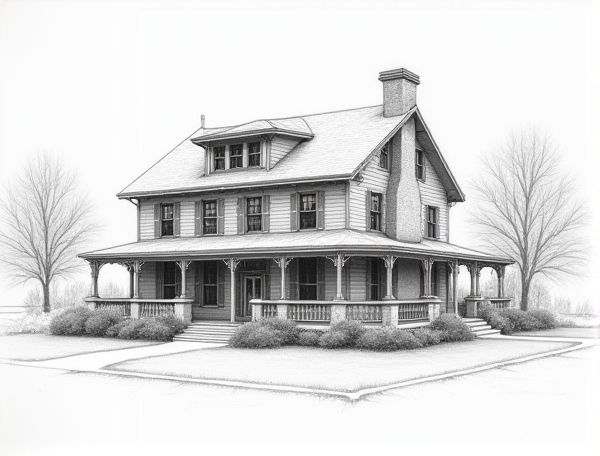
Photo illustration: Colonial Revival home design with dentil molding restoration
Enhance your Colonial Revival home's timeless elegance by restoring dentil molding, a classic architectural detail that adds depth and character to your facade. Discover expert tips and restoration techniques in the full article to bring authenticity and charm back to your historic design.
Introduction to Colonial Revival Home Design
Colonial Revival home design emphasizes symmetry, classical proportions, and decorative elements inspired by early American architecture from the 18th century. Key features include multi-pane, double-hung windows, columned porches, and gabled roofs often paired with brick or wood siding. This style blends timeless elegance with modern functionality, making it popular in suburban home construction and historic neighborhood revitalization.
Historical Significance of Dentil Molding
Dentil molding, originating from classical Greek and Roman architecture, serves as a distinctive decorative element symbolizing the refinement and craftsmanship of ancient civilizations. Its repeated rectangular blocks not only enhance aesthetic appeal but also connect modern home designs to historical architectural traditions, providing a timeless elegance that resonates with heritage and artisanal detail.
Key Features of Colonial Revival Architecture
Colonial Revival architecture showcases symmetrical facades, multi-pane double-hung windows, and decorative entryways with pediments or columns as key features. You'll notice side-gabled roofs and dormers that enhance the classic aesthetic. This style often incorporates brick or wood siding, emphasizing timeless elegance in home design.
Common Locations for Dentil Molding in Homes
Dentil molding is commonly found along the cornices of exterior rooflines, atop fireplace mantels, and framing doorways or windows, adding classic architectural detail to your home's design. Installing dentil molding in these strategic locations enhances visual interest and emphasizes structural elegance in both traditional and modern interiors.
Identifying Original vs. Reproduction Dentil Molding
Your ability to distinguish between original and reproduction dentil molding hinges on examining wood grain patterns, age-related wear, and construction techniques; authentic dentil molding typically features hand-carved irregularities and patina that reproductions lack. Detailed scrutiny of material composition and installation methods further aids in identifying genuine architectural elements that elevate your home's historical integrity.
Materials Used in Dentil Molding Restoration
Dentil molding restoration commonly employs durable hardwoods such as oak, maple, and cherry due to their fine grain and stability, ensuring long-lasting structural integrity. High-quality polyurethane and medium-density fiberboard (MDF) alternatives offer moisture resistance and ease of customization, making them ideal for intricate dentil designs in varying climates. Specialized restoration adhesives and wood fillers specifically formulated for carpentry enhance the durability and seamless finish of repaired or recreated dentil moldings.
Step-by-Step Dentil Molding Restoration Process
Restore dentil molding by first carefully removing old paint and debris using gentle scraping and sanding techniques to avoid damaging delicate wood details. Apply wood filler to repair cracks or chips, prime the surface thoroughly, and finish with a high-quality exterior paint to protect and highlight the molding's classic architectural elements.
Challenges in Restoring Historic Dentil Molding
Restoring historic dentil molding presents challenges such as matching original craftsmanship and sourcing period-appropriate materials to maintain architectural integrity. Preservation experts must balance structural repairs with aesthetic accuracy while navigating the fragility of aged wood and previous damage.
Enhancing Aesthetic Value with Dentil Molding
Dentil molding adds intricate architectural detail that elevates your home's aesthetic appeal by creating a sense of classical elegance and refined craftsmanship. Incorporating dentil patterns along cornices or cabinetry enhances visual interest and highlights design sophistication in any room.
Maintenance Tips for Restored Colonial Revival Dentil Molding
Regular dusting and gentle cleaning with a soft cloth and mild soapy water prevent grime buildup on restored Colonial Revival dentil molding. Inspect for signs of wood rot or loose segments quarterly, addressing repairs promptly with wood filler or matching paint to maintain structural integrity and visual appeal. Applying a fresh coat of high-quality, exterior-grade paint every few years protects the molding from moisture and UV damage, ensuring longevity.
 homedesy.com
homedesy.com